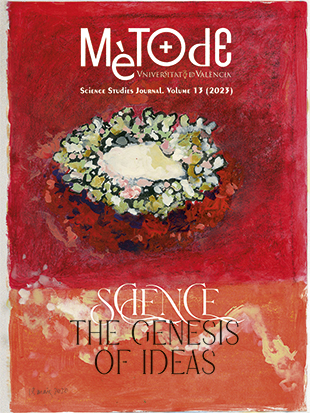¿Es la belleza criterio de verdad? Calidad genética o criterios estéticos, motores de la selección sexual en animales
DOI:
https://doi.org/10.7203/metode.13.24722Palabras clave:
selección sexual, biología, biología evolutiva, evolución Resumen
Resumen
¿Perciben la belleza de las flores la abeja o el colibrí que se acercan para quedarse con su néctar? Es decir, ¿pueden los animales no humanos apreciarla? ¿Existe una verdad universal sobre la belleza? ¿O no es más que un atributo útil, un indicador de un rasgo valioso? Como ocurre con tantos otros fenómenos naturales, no hay una respuesta simple a estas preguntas. En el siguiente artículo analizamos diferentes aspectos sobre la selección sexual y su relación, o no, con los criterios estéticos y con el llamado principio del hándicap.
 Descargas
Descargas
 Citas
Citas
Brown, S. (2022). Naturalizing aesthetics. In A. Chatterjee & E. R. Cardillo (2022), Brain, beauty, & art: Essays bringing neuroaesthetics into focus (pp. 18–21). Oxford University Press. https://doi.org/10.1093/oso/9780197513620.003.0004
Buskes, C. (2006). Evolutionair denken: De invloed van Darwin op ons wereldbeeld. Uitgeverij Nieuwezijds.
Chatterjee, A., & Cardillo, E. R. (2022). Prologue: Where have we been, and where are we now? In A. Chatterjee & E. R. Cardillo, Brain, beauty, & art: Essays bringing neuroaesthetics into focus (pp. XI–XII). Oxford University Press.
Darwin, C. (1860, 3 April). Letter to Asa Gray. Darwin Correspondence Project. https://www.darwinproject.ac.uk/letter/DCP-LETT-2743.xml
Darwin, C. (1877). The descent of man, and selection in relation to sex. John Murray.
DeAngelis, R. S., & Hofmann, H. A. (2020). Neural and molecular mechanisms underlying female mate choice decisions in vertebrates. Journal of Experimental Biology, 223(17), jeb207324. https://doi.org/10.1242/jeb.207324
Deutsch, D. (2011). The beginning of infinity. Explanations that transform the world. Viking.
Hoke, K. L., Burmeister, S. S., Fernald, R. D., Rand, A. S., Ryan, M. J., & Wilczynski, W. (2004). Functional mapping of the auditory midbrain during mate call reception. Journal of Neuroscience, 24(50), 11264–11272. https://doi.org/10.1523/JNEUROSCI.2079-04.2004
Kandel, E. R. (2016). Reductionism in art and brain science. Bridging the two cultures. Columbia University Press.
Keagy, J., Savard, J.-F., & Borgia, G. (2009). Male satin bowerbird problem-solving ability predicts mating success. Animal Behaviour, 78(4), 809–817. https://doi.org/10.1016/j.anbehav.2009.07.011
Keagy, J., Savard, J.-F., & Borgia, G. (2011). Complex relationship between multiple measures of cognitive ability and male mating success in satin bowerbirds, Ptilonorhynchus violaceus. Animal Behaviour, 81, 1063–1070. https://doi.org/10.1016/j.anbehav.2011.02.018
Li, Q., Gao, K.-Q., Vinther, J., Shawkey, M. D., Clarke, J. A., D’Alba, L., Meng, Q., Briggs, D. E., & Prum, R. O. (2010). Plumage color patterns of an extinct dinosaur. Science, 327(5971), 1369–1372. https://doi.org/10.1126/science.1186290
Moreno, J. (2013). Evolución por selección sexual según Darwin. La vigencia de una idea. Síntesis.
Nadal, M., & Cela-Conde, C. J. (2022). Bringing it all together. Neurological and neuroimaging evidence of the neural underpinnings of visual aesthetics. In A. Chatterjee & E. R. Cardillo, Brain, beauty, & art: Essays bringing neuroaesthetics into focus (pp. 8–11). Oxford University Press. https://doi.org/10.1093/oso/9780197513620.003.0002
Nagel, T. (1974). What is it like to be a bat? The Philosophical Review, 83(4), 435–450. https://doi.org/10.2307/2183914
Osuna, A. J. (2017, 17 September). Antropomorfismo [conference session]. Naukas, Bilbao. https://www.eitb.eus/es/divulgacion/naukas-bilbao/videos/detalle/5082718/video-naukas-bilbao-2017-antonio-j-osuna-biotay-antropomorfismo/
Prokop, Z. M., Michalczyk, L., Drobniak, S. M., Herdegen, M., & Radwan, J. (2012). Meta-analysis suggests choosy females get sexy sons more than «good genes». Evolution, 66(9), 2665–2673. https://doi.org/10.1111/j.1558-5646.2012.01654.x
Prum, R. O. (2012). Aesthetic evolution by mate choice: Darwin’s really dangerous idea. Philosophical Transactions of the Royal Society B, 367(1600), 2253–2265. https://doi.org/10.1098/rstb.2011.0285
Prum, R. O. (2017). The evolution of beauty: How Darwin’s forgotten theory of mate choice shapes the animal world – and us. Anchor.
Rosenthal, G. G., & Ryan, M. J. (2022). Sexual selection and the ascent of women: Mate choice research since Darwin. Science, 375(6578), eabi6308. https://doi.org/10.1126/science.abi6308
Ryan, M. J. (2018). A taste for the beautiful. Princeton University Press.
Sainani, K. (2015). Q&A: David Deutsch. Nature, 526, S16. https://doi.org/10.1038/526S16a
Zahavi, A. (1975). Mate selection – a selection for a handicap. Journal of Theoretical Biology, 53, 205–214. https://doi.org/10.1016/0022-5193(75)90111-3
Descargas
Publicado
Cómo citar
-
Resumen1120
-
PDF 766
Número
Sección
Licencia
![]()
Todos los documentos incluidos en OJS son de acceso libre y propiedad de sus autores.
Los autores que publican en esta revista están de acuerdo con los siguientes términos:
- Los autores conservan los derechos de autor y garantizan a Metode Science Studies Journal el derecho a la primera publicación del trabajo, licenciado bajo una licencia de Creative Commons Reconocimiento-NoComercial-SinObraDerivada 4.0 Internacional, que permite a otros compartir el trabajo con un reconocimiento de la autoría del trabajo y citando la publicación inicial en esta revista.
- Se permite y se anima a los autores a difundir sus trabajos electrónicamente a través de páginas personales e institucionales (repositorios institucionales, páginas web personales o perfiles a redes profesionales o académicas) una vez publicado el trabajo.





